We are a new lab that explores charge and spin dynamics in novel materials such as two-dimensional (2D) materials and heterostructures as well as at interfaces/surfaces. We are interested in experimentally studying and controlling material properties on the few and sub-femtosecond ( 1 fs = 10-15 s = 0,000 000 000 000 001 s) time scale to tackle challenging problems in quantum electronics and solar energy conversion. Aside from the material properties, future devices require nanointegration and, thus, studying carrier transport and interaction on the nanoscale becomes a necessity. For this, we develop new techniques in our group for spatially resolving dynamics on the nanometer length scale.
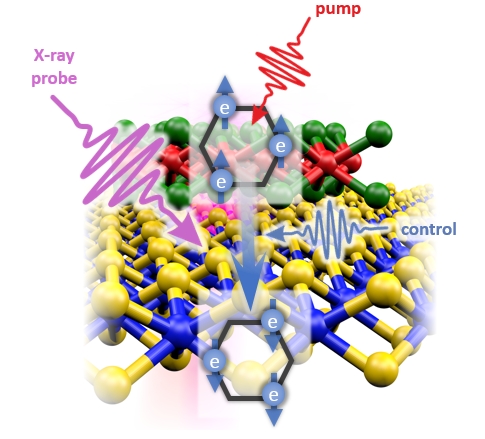
We study fastest dynamics of carriers and quasiparticles in novel materials and junctions with high temporal and spatial resolution. 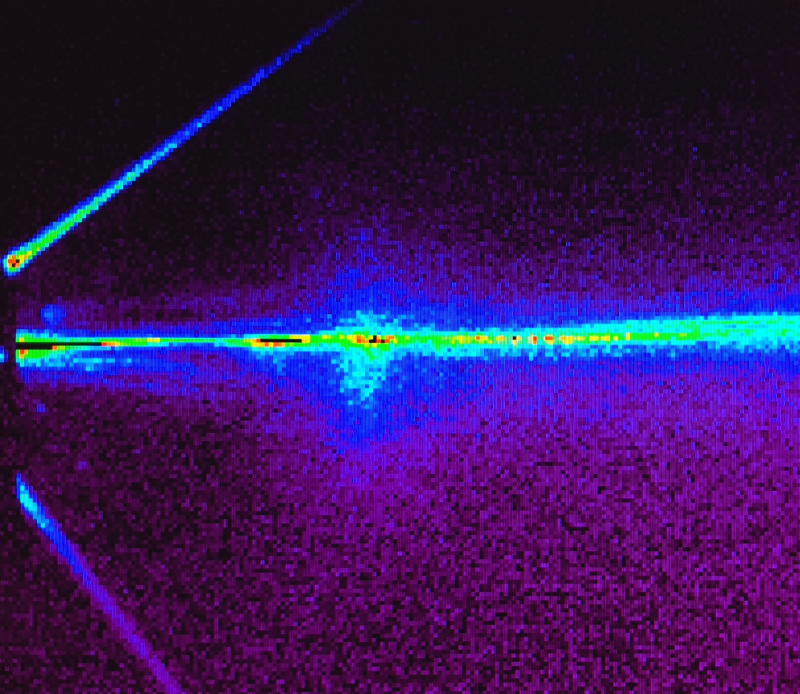
An extreme ultraviolet attosecond pulse scattering off a magnetic material with aligned spins. The blob-like area in the center of the image corresponds to resonantly diffracted light that hits the detector off-axis, while the non-scattered X-ray beam just misses the detector on the left side of the image. 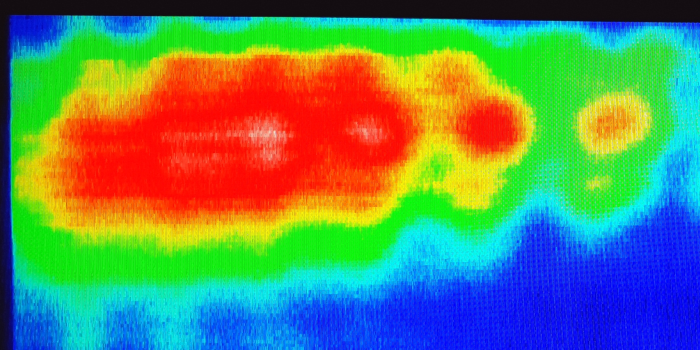
We convert extremely short optical laser pulses into broadband extreme ultraviolet and soft X-ray pulses to study light-matter interactions. This picture shows a spatially and spectrally resolved XUV pulse. The horizontal image axis corresponds to photon energies of 40 to 70 eV. 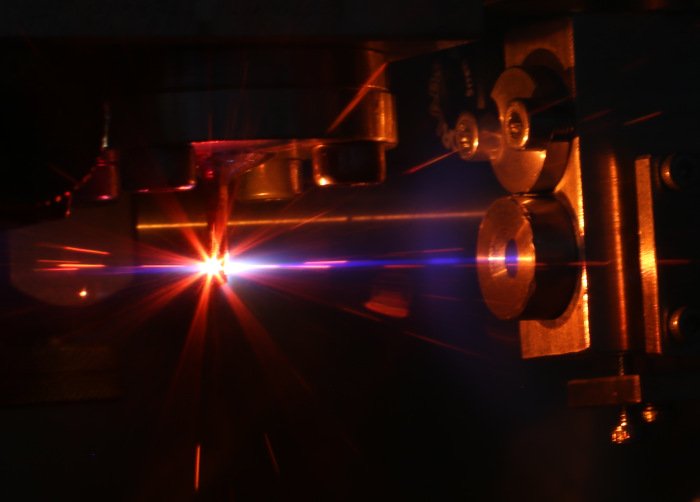
We develop nonlinear optical techniques in the lab and at facilities to perform cutting-edge experiments.
In our laboratory we perform cutting-edge experiments using state-of-the art laser-driven attosecond sources in the extreme ultraviolet and soft X-ray range. We employ transient absorption/reflection spectroscopy in combination with transient X-ray scattering as methods to study fastest processes in real-time. Further, we perform experiments at facilities such as free-electron lasers to study dynamics using nonlinear X-ray spectroscopies, which will allow accessing dynamics at surfaces and interfaces.
Open research projects include
- Measuring ultimate electronic switching times in technology-relevant semiconductor nanostructures by high-resolution femtosecond time-resolved imaging
- Timing valley-specific carrier and spin localization in two-dimensional semiconductors
- Multimodal probing of ultrafast spin dynamics in magnetic nanomaterials using attosecond diffraction spectroscopy
- Surface-sensitive nonlinear diffraction spectroscopy of nanostructured quantum materials (at free-electron laser)
-
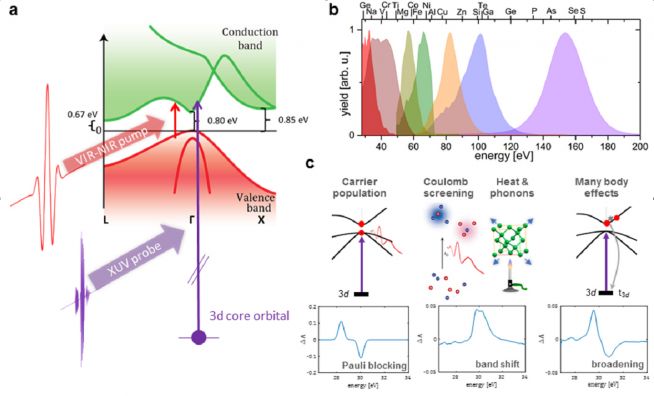
(a) Typical pump-probe scheme, here in germanium as example. A VIS-NIR pulse photoexcites the semiconductor, initiating valence to conduction band transitions. A time-delayed broadband XUV pulse probes the transient state of the material by promoting a core-level electron to unoccupied states. (b) Broadband attosecond pulse spectra are shown that can be produced across a wide spectral range, giving core-level access to dynamics in various materials. The energy separations allow probing different atomic species separately in semiconductor compounds. (c) Time-resolved XUV absorption spectroscopy allows measuring carrier populations, electronic effects such as Coulomb screening, lattice expansions (phonons) as well as many-body effects (e.g. carrier-carrier scattering), that each result in distinct spectroscopic signatures around the chosen absorption edge (exemplary differential XUV absorbances in germanium are indicated).
References:
S. K. Cushing, M. Zürch, P. M. Kraus, L. M. Carneiro, A. Lee, H.-T. Chang, C. J. Kaplan, S. R. Leone. Hot phonon and carrier relaxation in Si(100) determined by transient extreme ultraviolet spectroscopy, Structural Dynamics 5, 054302 (2018).
C. J. Kaplan, P. M. Kraus, A. D. Ross, M. Zürch, S. K. Cushing, M. F. Jager, H.-T. Chang, E. M. Gullikson, D. M. Neumark, S. R. Leone. Femtosecond Tracking of Carrier Relaxation in Germanium with Extreme Ultraviolet Transient Reflectivity, Physical Review B 97, 205202 (2018).
P. M. Kraus, M. Zürch, S. K. Cushing, D. M. Neumark, S. R. Leone. The Ultrafast X-ray Spectrocopic Revolution in Chemical Dynamics, Nature Reviews Chemistry 2, 82-94 (2018).
M. Zürch, H.-T. Chang, P. M. Kraus, S. K. Cushing, L. J. Borja, A. Gandman, J. S. Prell, D. Prendergast, C. D. Premmaraju, D. M. Neumark, and S. R. Leone. Carrier Thermalization and Trapping in Silicon-Germanium Alloy Probed by Attosecond XUV Transient Absorption Spectroscopy, Structural Dynamics 4 (4), 044029 (2017).
M. Zürch, H.-T. Chang, L. J. Borja, P. M. Kraus, S. Cushing, A. Gandman, C. J. Kaplan, M. H. Oh, J. S. Prell, D. Prendergast, C. D. Premmaraju, D. M. Neumark, and S. R. Leone. Direct and Simultaneous Observation of Ultrafast Electron and Hole Dynamics in Germanium, Nature Communications 8:15734, 1-11 (2017).
-
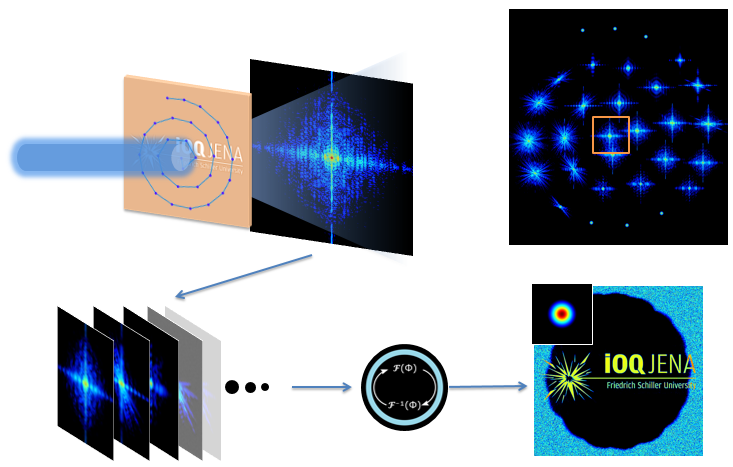
Imaging objects at nanometer resolution is a significant challenge since the achievable resolution in a microscope is limited the approximately half of the wavelength of the illuminating light. This limits the resolution of an optical microscope to few hundred nanometers. We push these limits by applying short-wavelength (extreme ultraviolet and soft X-ray) light sources for high-resolution imaging. The coherent nature of our sources allows us to employ a scheme called coherent diffraction imaging, where a detector directly measures the diffracted X-rays. Using advanced computer algorithms we perform the actual imaging in the computer by inverting the measured diffraction pattern by solving the so-called phase problem. Extending this method by raster-scanning an object, which is then called ptychography, we can retrieve nanoscale images with a literally infinite field of view and with high fidelity.
In our lab we strive for combining aspects of ptychograpahy and time-resolved spectroscopy to resolved nanoscale dynamics.
References:
M. Zürch, R. Jung, C. Spaeth, J. Tümmler, A. Guggenmos, D. Attwood, U. Kleineberg, H. Stiel and C. Spielmann. Spatial Coherence Limited Coherence Diffraction Imaging using a Molybdenum Soft X-ray Laser Pumped at Moderate Pump Energies, Nature Scientific Reports 7:5314, 1-10 (2017)
G.K. Tadesse, R. Klas, S. Demmler, S. Hädrich, I. Wahyutama, M. Steinert, C. Spielmann, M. Zürch, T. Pertsch, A. Tünnermann, J. Limpert and J. Rothhardt. High speed and high resolution table-top nanoscale imaging, Optics Letters 41 (22), 5170-5173 (2016)
M. Zürch and C. Spielmann. Extreme ultraviolet digital in-line holography using a table top source, Applied Optics 54 (19), 5992-5997 (2015)
M. Zürch, J. Rothhardt, S. Hädrich, S. Demmler, M. Krebs, J. Limpert, A. Tünnermann, A. Guggenmos, U. Kleineberg, and C. Spielmann. Real-time and Sub-wavelength Ultrafast Coherent Diffraction Imaging in the Extreme Ultraviolet, Nature Scientific Reports 4 (7356), 1-5 (2014)
M. Zürch, C. Kern, and Ch. Spielmann. XUV coherent diffraction imaging in reflection geometry with low numerical aperture, Optics Express 21 (18), 21131-21147 (2013)
-

In our lab we develop and employ light sources that have extremely short pulse durations. In the optical domain we routinely achieve pulse durations of a few femtoseconds covering the whole visible light spectrum and the near-infrared. Locking the electric field of the laser pulse to its envelope, so-called carrier-envelope phase stabilization, allows us to taylor optical and near-infrared laser pulses such that they can either be employed for phase-resolved excitation (“pump”) or for nonlinear up-conversion into the extreme ultraviolet and soft X-ray range (“probe”) allowing for transient absorption spectroscopy in the pump-probe scheme.
References:
R. Sollapur, D. Kartashov, M. Zürch, A. Hoffmann, T. Grigorova, G. Sauer, A. Hartung, A. Schwuchow, J. Bierlich, J. Kobelke, M. Chemnitz, Markus A. Schmidt, C. Spielmann. Resonanceenhanced multi-octave supercontinuum generation in antiresonant hollow-core fibers, Light: Science & Applications, 6, e17124 (2017)
H.-T. Chang, M. Zürch, P. M. Kraus, L. J. Borja, D. M. Neumark, and S. R. Leone. Simultaneous generation of sub-5-femtosecond 400 nm and 800 nm pulses for attosecond extreme ultraviolet pump-probe spectroscopy, Optics Letters 41 (22), 5365-5368 (2016)
M. Zürch, C. Kern, P. Hansinger, A. Dreischuh, and Ch. Spielmann. Strong-field physics with singular light beams, Nature Physics 8, 743-746 (2012)
S. Eyring, C. Kern, M. Zürch, and C. Spielmann. Improving high-order harmonic yield using wavefront-controlled ultrashort laser pulses, Optics Express 20 (5), 5601-5606 (2012)


